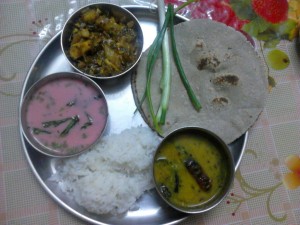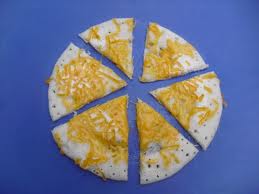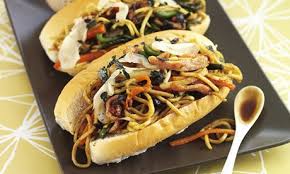Traditionally Thali is a meal usually served as lunch /dinner consisting of Rice and Roti / phulka / chapatti, Vegetable gravy curry, seasoned toasted curry (dry vegetable curry/ or chicken or egg in case of a non-vegetarian thali) Dal, Curds, fried crispies Pickle and Chutney. Amount of rice and roti varies depending on regional staple food grain. All southern and eastern states of India have rice as their staple cereal, while in North its Wheat, Maize and Bajra, in Western parts it’s a combination of rice and roti (Jowar- Sorghum vulgare), Bajra(Pennisetum typhoideum) and wheat) in 30/70 or 50/50.
However the way each recipe is cooked in different regions is strongly ruled by the crops and spices that are locally grown. Within the same region every house hold has a different way of making a recipe say for instance sambar (Lentils (masoor dal) or Red gram (turdal) cooked in plenty of water, tamarind juice, spices with one or more vegetables), I must have tasted at least thirty different versions of sambar with in Bangalore. Several of my Andhra friends complain of sweet taste of sambar in Bangalore, while Chennai friends complain of lack of spice and sourness, while Keralites want it with more pepper and chili powder for obvious reasons.
Thanks to sundry cookery shows on television, social media and boxed spice industry for not merely taking Indian food global, but has been instrumental in gradual standardisation of recipe. Especially if the person cooking is opting for ready to make spice mixes for sambar, rasam, Indian curries and several other dishes the use of the spice is well described in making of the recipe. In the coming decade I am sure at least 70 of the population would depend on packed spices or masalas and recipes might get more standardised and cooking methods more uniform across various regions. Tangentially the Indian recipes/ spices/vegetables and fruits are finding place with make overs that can sync with the foreign palate.
However I do not find this a welcome change since we miss out on the original regional traditional recipe that has survived over the years. I strongly believe in the fact that all traditional recipes which are homemade across the regions have a strong scientific base in preparing the recipe in a particular manner which balance the nutritional needs of individuals. There are several factors which rule the preparation of a particular food depending on the geographic location, vegetation, crops, soil, water sources, climate and socio-political set up.
As most of us are aware that traditional Indian recipes are cooked on a slow flame.With a combination of freshly ground spices and herbs, this method gives sufficient time for the food to absorb the essential oils from the spices and herbs and makes the dish abundant in readily available antioxidants along with the protein, carbs and fats associated with that particular food. This method is certainly losing ground as all these recipes are sliced up with new methods of fortification and easy cooking techniques. However this revised traditional dish lacks the natural flavours and wholesomeness. While it certainly gets fortified in terms of protein, fats and carbs. Decidedly the antioxidant levels of these foods certainly does not improve with the new methods adopted. The most pathetic twist ever , I have come across is the vadapav twist, noodles in place of potato vada. Imagine the refined carbs over load in this dish !
With the changing times and advances in cooking appliances we certainly save time but to retain traditional form of cooking at least let’s not mix-up global foods in our traditional recipes. Every Indian traditional recipe is a fine balance of food chemistry making every dish complete and neutral in nature and extremely nutritious and unassumingly delicious. For instance let’s look at the simplest and most popular summer recipe consumed across Indian, Mango pulp (Aam Rass) with Puri / Chapati /curd rice. We all know that Mango is rich in several anti-oxidants, fructose and several cancer fighting properties. Making a simple juice of the ripe fruit without additives is healthy , but traditionally Indians love eating Mango pulp, mixed with little ghee/ Milk and a pinch of salt along with Roti / Poori or Curd rice in Southern states.
Well let me tell you why this is more healthier than just guzzling down the mango juice thinned with water and unwanted sugar. Mango pulp is rich in sugars, vitamins and minerals and when complemented with milk or ghee (clarified butter) improves absorption of these essential nutrients without harming the gut and for easy bowel moments., compared to as is form in which the absorption is direct and you will find a spike in blood sugars. While when consumed with roti, poorie or curd rice (consumed in combination with a protein, fat and carbs combination) its absorption is slow and complete without causing any shocking changes in blood sugar levels. Hence ideally even if a diabetic loves to have a cup of mango pulp its ideal to take it along with a cereal food which will not spike the blood sugar levels as its released slowly along with complex combination of food.
This is one small and simplest example to understand the beauty of traditional methods, combination of foods and the hidden health benefits behind every recipe.
Promote traditional foods and traditional eating practices which are safest and avoid make overs of traditional foods. Globalisation of Indian foods to a certain extent is acceptable as long as the traditional methods and ingredients are used. However changing a few ingredients or adding a few more in the existing recipe will not only over load the nutritionally but also influence the digestive systems which many not be accepting it for its basic constitutional design adaptable for a particular geographic location. Like the paneer dosa, or cheese dosa.
 Do we really need to eat paneer or cheese in South of India? Well the answer is No keeping in view the traditional status of the Dosa and its goodness. A traditional dosa will have good amount of ghee or oil, apart from the traditional coconut, gram chutney with chilles and tampering, potato curry and sambar, makes it a wholesome and complete meal an ideal start for a breakfast. But imagine adding double dose of fat and protein in the form of cheese and paneer will essentially spoil the balance of the entire breakfast. So eating traditional foods will not a make you fat, eating traditional food with an international twist will certainly make you feel world is round physically and mentally! If this article crosses the eyes of chefs, cooks and cooking enthusiasts request is let the original be original , remember old is gold, twist of taste may not go with the tongue and bellies of millions across the globe. Imagine making a burger with beans and bottle guard filling, will this be appreciated and liked by our burger eating nations? Answer is certainly not! Let’s not pollute our traditional foods with unwanted ingredients. However the idea behind this write up is undoubtedly not to kill your experimental approach to dish out new food varieties, concern has been regarding, adoption of food ingredients used in other parts of the world and mixing it with traditional Indian recipes. Traditional Indian foods are sacred and let us sanctify and stick to the original methods of making them, to retain its health benefits and palatability.
Do we really need to eat paneer or cheese in South of India? Well the answer is No keeping in view the traditional status of the Dosa and its goodness. A traditional dosa will have good amount of ghee or oil, apart from the traditional coconut, gram chutney with chilles and tampering, potato curry and sambar, makes it a wholesome and complete meal an ideal start for a breakfast. But imagine adding double dose of fat and protein in the form of cheese and paneer will essentially spoil the balance of the entire breakfast. So eating traditional foods will not a make you fat, eating traditional food with an international twist will certainly make you feel world is round physically and mentally! If this article crosses the eyes of chefs, cooks and cooking enthusiasts request is let the original be original , remember old is gold, twist of taste may not go with the tongue and bellies of millions across the globe. Imagine making a burger with beans and bottle guard filling, will this be appreciated and liked by our burger eating nations? Answer is certainly not! Let’s not pollute our traditional foods with unwanted ingredients. However the idea behind this write up is undoubtedly not to kill your experimental approach to dish out new food varieties, concern has been regarding, adoption of food ingredients used in other parts of the world and mixing it with traditional Indian recipes. Traditional Indian foods are sacred and let us sanctify and stick to the original methods of making them, to retain its health benefits and palatability.

